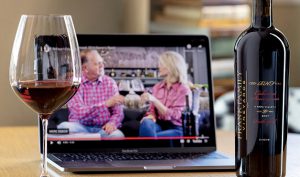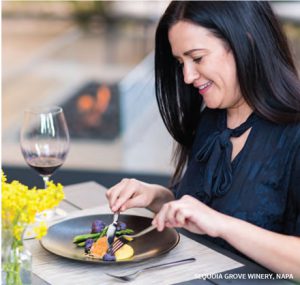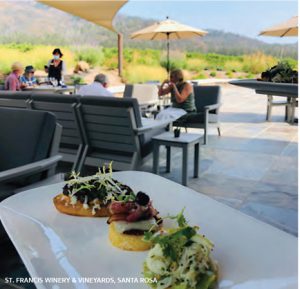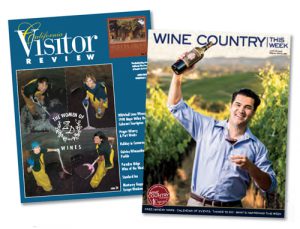




40 Years of Wine Country This Week
From one magazine to six titles and a website ... and growing!
Then … and Now
In 500 BC, the Greek philosopher Heraclitis said,
“the only thing that is constant is change.”
And such has been the case in California’s Wine Country
The world was different back in the early ’80s. Mullets and “big hair” were popular trends, along with parachute pants, leg warmers and Cabbage Patch Kids. But fads and trends come and go, and in the wine world there was about to be a major trend shift as the ’70s decade was approaching its close.
A few years earlier, in 1976 at the Judgment of Paris, Napa wineries shocked the wine world. Chateau Montelena won the California vs. French Burgundy Chardonnay class competition, and Stag’s Leap Wine Cellars won the California Cabernet Sauvignon vs Bordeaux class competition. This revolutionized Napa Valley, and subsequently the California wine industry. The effects of this competition would start to manifest themselves in the 1980s. Napa Valley wineries would lead California as serious players in the world of wine.
The year 1981 saw our inaugural publication of the California Visitor Review (changing our name in 2002 to: Wine Country This Week). This publication has been a staple ever since, helping visitors navigate Northern California’s Wine Country and telling stories of this wine-culture lifestyle.
Forty years later, California’s wine regions have become world renown wine destinations, dramatically changing the 1980s perception of California wine and wine country visits.
Wine Country This Week has been informing wine country travelers where to go, and what to see, week by week, for the past 40 years, making wine country outings special.
––––––––––––––––––––
Wine Country Fun Facts:
• 1976: The Judgment of Paris puts Napa on the map!
• 1978: Robert Parker began The Wine Advocate … and what an influence he has been for over 40 years.
• 1980: There were approximately 100 wineries in Napa … today, the count is over 500.
• 1980: Approximately 28,000 acres were under vine in Napa. Today there are approximately 43,000 acres.
• 1981: Napa Valley became the first AVA (American Viticultural Area) in California … today there are 16 “nested,” Napa AVAs and 139 throughout California. (Note: Napa Valley is itself an AVA, so with the sub-AVAs the total is 17).
––––––––––––––––––––
Where Changes Happened – Upping the Game
Tasting Rooms – Let’s Go Winetasting! That simple phrase meant something different back in the ’80s than it does now. I was in my 30s, and wine tasting was pretty much just a fun, social getaway for a day or so; it was more about camaraderie than about drinking GOOD wine or learning about wine.
Back then, wine tasting was mostly free. Over the years that evolved into a $5 charge, but you got to keep the glass! AND, when you brought back the glass on a re-visit, your tasting was free!
Today, there are still a few tasting rooms that are free. However, the majority charge, but the experience is much more elevated than it was “back in the day.” Tasting menus may range from whites to reds to mixed to special varietals or vintages. You’ll sip and learn while having fun! Wine tasting has evolved into an experience, and may include wine and food pairings, blending education, even vineyard, cave, and winery tours. The crowd is more sophisticated today, and eager to sip, learn and enjoy.
In early 2020, the wine tasting experience was shocked by Covid-19, and the in-person experience was again changed. Total lockdowns preceded partial re-openings. Now, reservations are generally required, numbers are kept down, and services have changed.
As California re-opens, it is likely that several of these Covid-19 changes will remain in place, such as reservations, smaller groups, and distancing. Time will tell, but wineries have been quick to respond in many ways to keep the consumer involved, tasting, and having fun!
––––––––––––––––––––
ENTER ZOOM!
Whereas virtual sales meetings and some virtual tastings had already been in use for a few years, the pandemic brought this to the forefront … creating a whole new category dedicated to reaching the consumer. Wineries started being creative with personalized ZOOM tastings: Some large group, some are small, and some are one on one. Special ZOOM virtual tasting kits containing 2-ounce or 4-ounce sample bottles, or a selection of full bottles, are sent out upon signing up for a ZOOM. Some wineries offer options to purchase a cheese and charcuterie board to go along with your tasting. All the customer needs to do is sign up, place the order, and overnight shipments will be made a few days before the pre-arranged ZOOM tasting. You and your group will then spend about an hour with the winemaker or wine educator, one on one, tasting through the wines, explaining just about anything that you want to know about the wines, the terroir, the winery, history, etc. Educational … fun … personal!
And, some wineries really upped the experiential bar, offering virtual gourmet cooking classes – where the customer receives a list of ingredients (plus wines to pair), and then spends an hour or two cooking a full gourmet meal along with an executive chef. WHAT FUN!
Being able to reach customers virtually, across the country, who may only visit California wine country occasionally has opened a whole new area of consumer marketing. This virtual marketing space has grown exponentially over the last twelve months and is now an integral part to winery marketing programs … it is here to stay.
First Came the Wine, THEN came the Food!
Dining in Style: In 1973 Moet & Chandon purchased vineyards in Napa Valley, opening their fine dining restaurant, Etoile, in 1977. Was this coincidental, one year after Napa showed so well in The Judgment of Paris? Regardless, this started a trend … as more and more wineries opened, and elevated food experiences became prevalent throughout the area. Today, Napa Valley and the surrounding area have become famous as a gourmet dining hub. World-class chefs and cuisine abound in Napa Valley, and the food scene has spread to other California wine regions including the Central Coast (Paso Robles and the Santa Barbara areas). World-class wines with world-class food, offer travelers a world-class experience. And, along with the food, came elite lodging: Luxurious vineyard inns, bed and breakfasts and elegant hotels. California, with its overall inviting climate (even taking climate change into effect) has matured, becoming a true destination for wine and food lovers from all over the world.
Wine, Food & Education: In the beginning, well, in the early ’80s, you would visit a winery for wine tasting and that’s what you got … wine tasting. It was basically: here’s a Chardonnay, here’s a Cabernet. There may have been informal vineyard and winery tours, but wine tasting then was more of just a fun day trip. Most people weren’t really serious about the wine.
Today, wine tasting is an adventure. In addition to more elevated tasting menus, it’s not unusual to have wineries offer options to compliment your wine tasting experience. That may include a cheese and charcuterie platter, small bites, specially wine-paired accompaniments or a full menu. Many wineries have chefs on staff. And the specialized tasting experiences being offered are amazing: Blending sessions, vertical tastings, varietal tastings, vineyard tours. Your host may be the winemaker or a well-educated and trained wine ambassador. You can certainly go and just taste but there are so many options today, which makes “wine tasting” a true experiential event!
Sales and Marketing: Brand building was much different back in the ’80s for many reasons. In Northern California alone, there were about 12 distributors – and they promoted, sold, and built brand names and awareness. As time went on, not only was there a major consolidation within the distributor network (down to just a few today in the same NorCal market) but with the addition of more wineries – more wines – and 10,000 plus SKUs – the onus is on the winery to be much more pro-active to building their brands regionally and nationally.
One thing that seems to be agreed upon from various industry experts is that despite all the virtual tastings and creativeness wineries have shown during the pandemic, if you want to get your wine to the retailer or restaurant, the wine merchant still must hit the road, sample out the wines, and sell the wine face to face. This is still a person-to-person business.
• • •
Ecological Impact-the Environment
Climate Change: Certainly, climates have always changed. Humankind however has had quite an impact on the environment, and therefore changes that effect the wine industry. Over the past 40 years we have become more and more cognizant and aware of those changes and their effects. Weather patterns are changing and becoming more pronounced. We have experienced more severe and frequent changes in weather patterns and events over the last several decades. Witness the severity of droughts, devastating forest fires, and extremes in weather conditions.
This affects wine country in many ways that the average visitor may not consider, as they sip their glass of Cabernet or Syrah: Adaptation has become not just a buzz word but a key word. Wineries must adapt to unusual cold and heat, wind, and drought conditions. This affects planning on how to maintain the vineyard, how to manage canopies, irrigation, and determining what kind of grapes may or may not grow as well in the future. Along with that, tourism also needs to be considered. Fires, freezes, extreme weather, drought, prolonged temperatures in the 100s all can affect farming practices, as well as tourism. You might argue that what used to be the unusual and unexpected, has been becoming more the norm.
In the last many years, it has become evident that the wine industry must work on and with the environment and be ahead of the curve. Technology and science play an important role in projecting “what ifs,” modeling and planning, both near and long term. Whereas Napa Valley has generally been considered THE Cabernet capitol, year after year … is it possible that in 10 or 20 years other varieties will flourish and take the place of this king of grapes? Time and weather change and how we deal with that will help decide the future of growing.
A Healthy Planet: There has been a concentrated move toward more natural, organic, and sustainable modes of farming and growing, in recent years, including conservation and preservation of resources. Today’s growers, farmers and winery owners are much more focused on the health of the ecosystem and the planet. In terms of wineries and vineyards, there is more emphasis on using organic and even Biodynamic farming practices. But this goes further than just concentrating on the dirt, it also includes wineries reducing their carbon footprint by increasing energy efficiency, adding solar energy, recycling, and implementing “green” purchasing.
Napa Green: Climate change, although starting to be somewhat recognized in the 1980s, didn’t become a serious issue to be acted upon until the late 1990s. Today, there is an emphasis on more responsible farming practices, cutting down the carbon footprint, and simply “saving the Earth.” Napa Green has been a trendsetter in the Napa area since their formation in 2004. Today, Napa Green is one of only four sustainable winegrowing programs nationally, offering comprehensive “soil to bottle” certification in the vineyard and winery.
The Napa Green certifications focus on climate action, regenerative farming, energy and water efficiency, waste prevention, green purchasing, and social equity. The goal for the new Napa Green Vineyard Certification is for growers to attain carbon neutrality by 2027 and be carbon negative by 2030.
“Napa Green serves as a catalyst and facilitator to grow certified sustainable, responsible businesses committed to environmental stewardship and climate action in Napa County.” This is their mission statement … it should be everyone’s mission.
For more detailed information, visit: www.napagreen.org.
• • •
Nothing New Under the Sun – Just Improved
Wine Production: 6,000 years ago, amphora were commonly used in wine production. Fast forward to the late 1970s and early 80s, the common method of ageing wine was in oak barrels. At that time most of the oak was American oak, and a good (and inexpensive substitute) was to use bourbon barrels to age wine. Today, more sophisticated barrel ageing is prevalent. European oak from France, Hungary, other European forests, and areas of the United States are used. However, as opposed to forty years ago, like a vineyard designated or block designated wine, barrels come from different forests and are even chosen from specific blocks of forest. Additionally, 6000 years later, amphora and cement containers (eggs) are widely used in producing and ageing wine. There truly is nothing new under the sun. Old technology is back … better than ever.
Technology: The effect on technology in many areas has enriched the overall wine industry. Because of technology in the vineyard, in the winery and in sales – opportunities abound that were not present 40 years ago. Being able to monitor and predict moisture in the vineyards through science and technology, the use of optical sorters, improved methods of fermenting, destemming machines, UV systems for sanitation and new technology for developing equipment that simply didn’t exist almost half a century ago, has raised the bar and quality of wine. Where high quality wine of the ’80s is equal to high quality wine today, the lower end has improved dramatically, where today the concept of “bad wine” has mostly been eliminated.
The COVID-19 Effect – Now and Going Forward: 1976-2019 saw changes in California’s wine industry that brought California to the center of the world stage in terms of wine, food, and hospitality. World-class winemakers, cult wines, gourmet restaurants, Michelin chefs, new and improved experiences, luxury lodgings from Napa Valley down through the state of California. Areas like Napa, Sonoma, Paso Robles, Santa Barbara, and smaller wine regions all have made their mark, enjoying specialty niches. Some of the changes in growing and recognition evolved, some happened quickly. Perhaps, however, the one most significant event that instantly changed the wine industry and will have long lasting effects on every aspect, was the Covid-19 Pandemic.
Covid-19 upended the world … and the hospitality industry, of which the wine industry is significant. Closings, openings, partial openings, more closings, adjustments in every area of growing, harvesting, making wine, tasting wine, selling wine, promoting wine … not to mention travel-food service and lodging immediately changed us as consumers, and the entire industry. There was simply no playbook on how to react to Covid-19.
But, amongst the upheaval, vines and grapes kept growing, needing to be picked, sorted, turned into juice, blended, put in barrels, and made into wine. And sales needed to happen. The wine industry … those imaginative, creative vintners, winemakers, and general managers responded quickly and effectively, thinking outside of the box … WAY outside of the box. Many of the procedures, virtual events and other changes will continue in place and promote California wines across a much broader spectrum, to a much larger audience.
Wine Country Publications
40 Years and Growing Strong
First published in 1981, The California Visitor Review was the first regional magazine focused on educating the consumer how to explore California’s Wine Country. Containing articles highlighting wineries, restaurants, lodging and just fun information about Northern California’s wine country, this magazine was distributed to wineries, hotels, restaurants, retailers, and other locations throughout the area. Check into a hotel, read an article, plan your day. Changing its name to Wine Country This Week in 2002 (focusing on Northern California wine country), then adding Wine Country This Month in 2006 (focusing on the Central Coast), these publications became mainstream. Very Napa Valley magazine, (introduced in 2015, published semi-annually) concentrates on Napa Valley’s premier wine, food, and exploratory experiences. With the addition of the annual hotel guide book in 2017, Latitude 35° focuses on “all” that is the Central Coast. These wine country publications have become a staple and important resource for California’s wine country visitors.
During last year, when the magazine suspended their print issues, Wine Country’s digital platform has served to keep wine country lovers up to date with what was happening in California’s Wine Country, from Napa down through Santa Barbara.
NOW: WINE COUNTRY THIS WEEK IS BACK IN PRINT, chock full of the latest news, offers and information about Northern California’s wine and dine playgrounds. As you begin your revised Covid-19 travels, look for their magazine where you stay, where you eat, where you visit. Happy 40th Anniversary!
The Bottom Line: California’s Wine Country has changed significantly in the last 40 years. What used to be a fun day trip or couple of days (bellying up to the bar) has morphed into an industry that offers amazing experiences, from casual to premium adventures in wine, food, lodging, attractions, and education. Up close and personal wine and food, experienced virtually, online is an exciting addition that will just get better. There are more choices and more opportunities for every taste and budget than ever before. And the challenges, whether they be by fire, rain, or pandemic, are met head on and creatively by the people who live in and love wine country. Always with an attitude of moving forward, changing, adapting and most of all … welcoming.Cheers!
• • •
Note: A special “thank you” to the following people & organizations for their time and insight on how California’s Wine Country has changed over the last 40 years: Peter Mondavi (Charles Krug Winery), Ralph Hertelendy (Hertelendy Vineyards), Juliana Colangelo (Colangelo & Partners), Teresa Wall (Napa Vintners), Chris Taranto (Paso Robles Wine Country Alliance), Anna Brittain (Napa Green), Larry Schaffer (Tercero Wines), Phil Carpenter (Santa Barbara Vintners Association).
• • •
Don Sonderling is a freelance writer covering California’s Wine Country lifestyle and culture, from the Central Coast up through the Napa Valley. He may be reached at: donsonderling@gmail.com
––––––––––––––––––––
Fun Facts and Figures
• Napa Valley has 5 million visitors annually, only Disneyland has more.
• Early 1980s: 712 (California) wine producers, today there are more than 4,000 (statewide)
• Family Ownership: Despite headline publicity of large corporations buying up family wineries, today approximately 92% of Napa’s wineries are family owned and 95% in Paso Robles.
• Many of the wineries in California are small, boutique producers. Wines are generally available only at the winery or through the wine club.
• 1979 Silver Oak (Napa) became one of Napa’s first vineyard designated wines. Today, it is not unusual for wineries to have small-lot, vineyard-designated wines.
• As the wine industry has matured, even “big names” that produce in the hundreds of thousands of cases may also offer small-lot, boutique-production wines, only available directly from the winery.
• Up until recently, intelligence was human. Today, “smart predictions” with sophisticated AI (artificial intelligence) is in use, helping to predict yields, quality, harvest timing, irrigation, weather, and a multitude of “wine growing variables.” The future is now – and we are blessed to live and experience that future, in California’s Wine Country.
Making the commitment to third party certification takes time and effort, but it is worth it to demonstrate our commitment to the community and to protect our watershed, our land and the air we breathe.
- Susan Boswell, Chateau Boswell Winery
